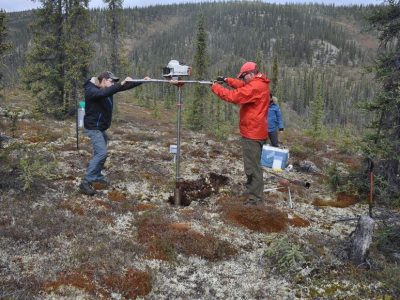We were recently funded to build the Permafrost Archives Science Laboratory (PACS Lab) which is an ice-core styled lab focused on Permafrost characterization and analyses of permafrost-preserved records for a variety of applications. The funding is for just over $4M and will include new clean labs for biogeochemical and genomic sampling from permafrost cores, an associated archive freezer, core cutting room, and new analytical laboratory, CT and core scanner that should allow most analyses that can be done on permafrost cores. The lab is under construction and is anticipated to be complete in the Spring of 2019. The story by Hina Alam is online here
Author: labadmin
A new genus of horse from Pleistocene North America
We recently published a paper clarifying the origins of a distinctive group of Ice Age horses, the New World Stilt-legged horses. These horses have very distinctive metapodials that when you see them in the field they jump out as very thin relative to the more robust form of the common Equus lambei forms we commonly find. Pete Heintzman, who was a post-doc with Beth Shapiro’s group and working on some of our Klondike materials in the Yukon collection along with some fossils we recovered in 2010, isolated mitochondrial and nuclear DNA from these fossils and showed that the stilt-legged horses were not related to the living Asiatic asses such as the Tibetan Kulan or Persian Onager, but rather their own separate New World branch of horses. And importantly not just a new species, but actually a whole new genus that we call Haringtonhippus after UofA Alum and palaeontologist-extraordinaire C.Richard Harington from the Canadian Museum of Nature who first described the Yukon horses.
Pete wrote a popular version of the story here.
Toronto Star Article on first bison
Bison arrival to North America
Fig. 2. Reconstructions of bison skulls based on fossils attributed to (A) a giant long-horned bison, B. latifrons; (B) a Late Pleistocene steppe bison, B. priscus; and (C) a present-day B. bison. Giant long-horned bison were significantly larger than present-day bison; adult males may have weighed in excess of 2,000 kg, which is twice as large as present-day bison, and had horns that spanned as much as 2.2 m (57, 58).
This spring we published a paper that was a little more than a decade in the making. We have recovered, over the years, bison fossils from a lot of localities in the Yukon and Alaska, but just what is the earliest bison record? Well the literature is pretty muddled on the topic and based on our work over the last 15 or so years, we were pretty convinced that they don’t go beyond MIS 6. We were able to confirm that from some excavations we did along the Old Crow River at a site called CRH12 (after C. Richard Harington, UofA alumnus and Quaternary vertebrate curator-extraordinaire (though now retired) from the Canadian Museum of Nature) that despite a very rich fauna – there were no bison. This is consistent with our work in central Yukon, interior Alaska etc. We never find bison younger than latest MIS 6 (or more commonly) in last interglacial (MIS 5) and later deposits. We joined up with my frequent collaborator Beth Shapiro at UCSC to get ancient DNA from some of these early fossils, including the earliest one that we could constrain very tightly to late MIS 6 from the Old Crow area along the Porcupine River. That fossil, not surprisingly sat basal in the tree from all other North American bison, indicating that this was indeed the earliest North American bison and sat quite close in the tree to a Bison latifrons fossil from Colorado that dated to the last interglacial.
This is where it gets interesting. B. latifrons is the giant horned bison with the 2 m+ horn span that is generally regarded as the ‘first’ bison in the continental U.S., but has never been found in Alaska or Yukon, where presumably they should since bison only arrived from Asia in the late-Middle Pleistocene (as we establish). This means that B. latifrons must have evolved from our northern steppe bison (Bison priscus) after it arrived in the south. Up until this paper was published, despite so much work that has been done on bison, B. latifrons DNA has never been sequenced. So in short, we put a very nice chronology to the arrival of North American bison, which just happens to coincide with the start of the Rancholabrean North American Land Mammal Age, and showed that the steppe bison that first colonized North America (B. priscus) quickly morphed into the giant horned bison, B. latifrons very quickly. Much of this was speculated on by R. Dale Guthrie more than 40 years ago, but it’s nice when the science aligns to support it. The paper was published in Proceedings of the National Academy of Sciences of the U.S.A.
Anthropocene Poetry
I had the opportunity to introduce Alice Major’s new collection of poems entitled ‘Welcome to the Anthropocene’ at the UofA Observatory. I gave a short presentation on the science of the Anthropocene to a very a very literate crowd. It was great fun- and an excerpt from Alice’s book:
This home. Clouds, oceans, life forms span it
from pole to pole, within a peel of air
as thin as lace lapped round an apple. Fair
and fragile bounded sphere, yet strangely tough—
this world that life could never love enough.
And yet its loving-care has been entrusted
to a feckless species, more invested
in the partial, while the total goes unnoticed.
— from “Welcome to the Anthropocene”



